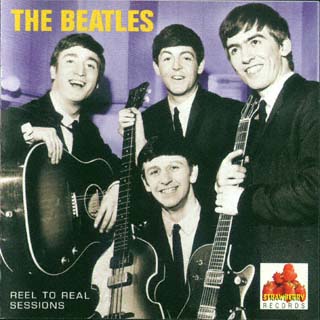
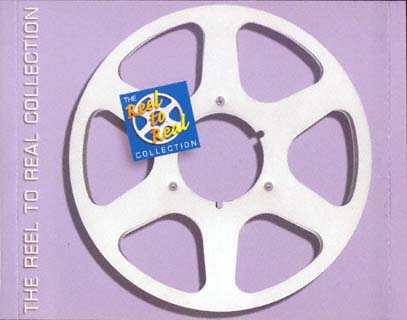
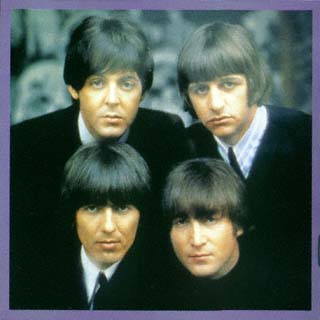
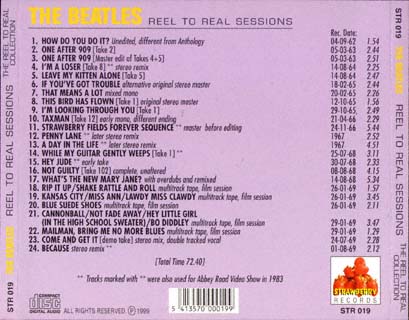
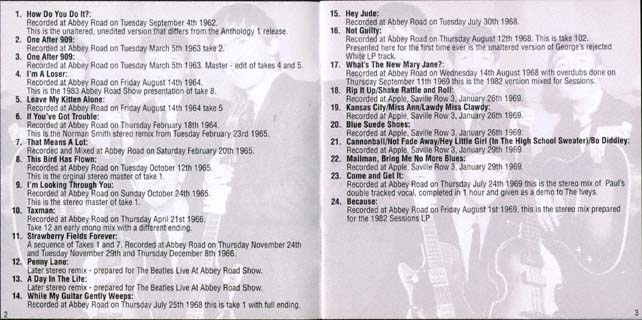


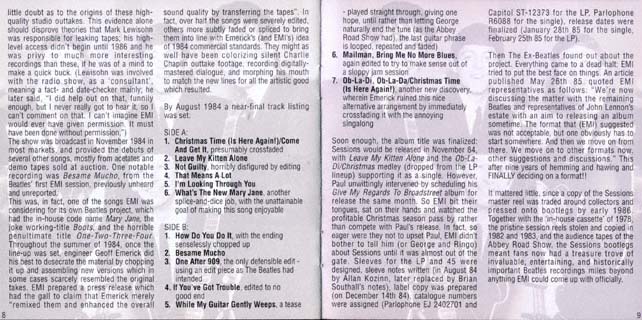
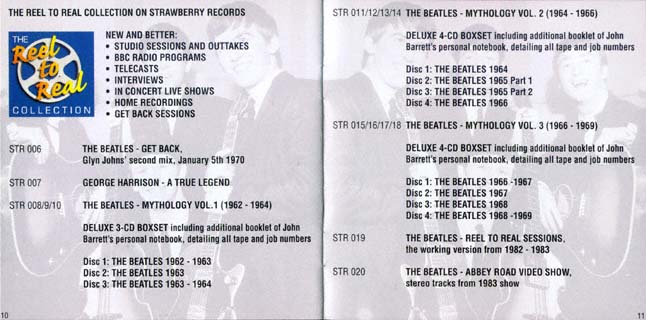
| Label | Strawberry Records |
| Part No. | STR019 |
| Country of origin | Europe |
| Release date | December 1999 |
| Total time | 72:40 |
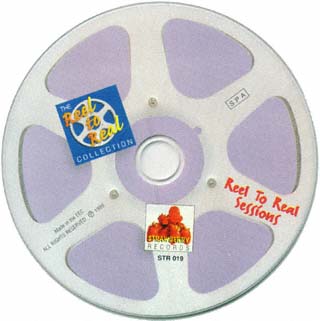
The Beatles
 |
 |
||||||||||
 |
 |
||||||||||
 |
|||||||||||
 |
|||||||||||
 |
|||||||||||
 |
|||||||||||
 |
|||||||||||
|
 |
||||||||||
| Tr | Title | CD notes | Time |
| 1 | How Do You Do It ? | 4-9-62, unedited, different from Anthology | 2:01 |
| 2 | One After 909, Take 2 | 5-3-63 | 2:44 |
| 3 | One After 909, Master edit of Takes 4+5 | 5-3-63 | 2:52 |
| 4 | I'm A Loser, Take 8 * | stereo remix, 14-8-64 | 2:29 |
| 5 | Leave My Kitten Alone, Take 5 | 14-8-64 | 2:51 |
| 6 | If You've Got Trouble | alternative original stereo master, 23-2-65 | 2:46 |
| 7 | That Means A Lot | mixed mono 20-2-65 | 2:27 |
| 8 | This Bird Has Flown, Take 1 | original stereo master, 12-10-65 | 1:59 |
| 9 | I'm Looking Through You, Take 1 | 29-10-65 | 2:50 |
| 10 | Taxman, Take 12 | original mono, different ending, 21-4-66 | 2:31 |
| 11 | Strawberry Fields Forever Sequence * | master before editing, nov. 66 | 5:46 |
| 12 | Penny Lane * | stereo remix | 2:54 |
| 13 | A Day In The Life * | stereo remix | 4:52 |
| 14 | While My Guitar Gently Weeps, Take 1 * | 25-7-68 | 3:14 |
| 15 | Hey Jude * | early take, 30-7-68 | 2:35 |
| 16 | Not Guilty, Take 102 | complete, unaltered, 12-8-68 | 4:48 |
| 17 | What's The New Mary Jane ? | 14-8-68, with overdubs and remixed | 5:35 |
| 18 | Rip It Up / Shake Rattle and Roll | 26-1-69 | 1:59 |
| 19 | Kansas City / Miss Ann / Lawdy Miss Clawdy | 26-1-69 | 3:44 |
| 20 | Blue Suede Shoes | 26-1-69 | 2:11 |
| 21 | Cannonball / Not Fade Away / Hey Little Girl (In The High School Sweater)/ Bo Diddley | 29-1-69 | 3:45 |
| 22 | Mailman, Bring Me No More Blues | 29-1-69 | 1:30 |
| 23 | Come and Get It, demo take | 24-7-69, stereo mix, double tracked vocal | 2:31 |
| 24 | Because, stereo remix * | 1-8-69 | 2:16 |
* Tracks marked with * were also used for Abbey Road Video Show in 1983
- How Do You Do It?
Recorded at Abbey Road on Tuesday September 4th 1962. This is the unaltered, unedited version that differs from the Anthology 1 release.- One After 909
Recorded at Abbey Road on Tuesday March 5th 1963 take 2.- One After 909
Recorded at Abbey Road on Tuesday March 5th 1963. Master - edit of takes 4 and 5.- I'm A Loser
Recorded at Abbey Road on Friday August 14th 1964. This is the 1983 Abbey Road Show presentation of take 8.- Leave My Kitten Alone
Recorded at Abbey Road on Friday August 14th 1964 take 5- If You've Got Trouble
Recorded at Abbey Road on Thursday February 18th 1964. This is the Norman Smith stereo remix from Tuesday February 23rd 1965.- That Means A Lot
Recorded and Mixed at Abbey Road on Saturday February 20th 1965.- This Bird Has Flown
Recorded at Abbey Road on Tuesday October 12th 1965. This is the orginal stereo master of take 1.- I'm Looking Through You
Recorded at Abbey Road on Sunday October 24th 1965. This is the stereo master of take 1.- Taxman
Recorded at Abbey Road on Thursday April 21 st 1966. Take 12 an early mono mix with a different ending.- Strawberry Fields Forever
A sequence of Takes 1 and 7. Recorded at Abbey Road on Thursday November 24th and Tuesday November 29th and Thursday December 8th 1966.- Penny Lane
Later stereo remix - prepared for The Beatles Live At Abbey Road Show.- A Day In The Life
Later stereo remix - prepared for The Beatles Live At Abbey Road Show.- While My Guitar Gently Weeps
Recorded at Abbey Road on Thursday July 25th 1968 this is take 1 with full ending.- Hey Jude
Recorded at Abbey Road on Tuesday July 30th 1968.- Not Guilty
Recorded at Abbey Road on Thursday August 12th 1968. This is take 102. Presented here for the first time ever is the unaltered version of George's rejected White LP track.- What's The New Mary Jane?
Recorded at Abbey Road on Wednesday 14th August 1968 with overdubs done on Thursday September 11th 1969 this is the 1982 version mixed for Sessions.- Rip It Up/Shake Rattle and Roll
Recorded at Apple, Saville Row 3, January 26th 1969.- Kansas City/Miss Ann/Lawdy Miss Clawdy
Recorded at Apple, Saville Row 3, January 26th 1969.- Blue Suede Shoes
Recorded at Apple, Saville Row 3, January 26th 1969.- Cannonball/Not Fade Away/Hey Little Girl (in The High School Sweater)/Bo Diddley
Recorded at Apple, Saville Row 3, January 29th 1969.- Mailman, Bring Me No More Blues
Recorded at Apple, Saville Row 3, January 29th 1969- Come and Get It
Recorded at Abbey Road on Thursday July 24th 1969 this is the stereo mix of Paul's double tracked vocal, completed in 1 hour and given as a demo to The Iveys.- Because
Recorded at Abbey Road on Friday August 1 st 1969, this is the stereo mix prepared for the 1982 Sessions LPThis is the story of a planned, but cancelled Beatles album named Sessions. It was to be a collection of unreleased Beatles' material issued on a single LP. Some of the mixes prepared for this project 6ventually found their way to The Beatles' Anthology collections. Originally posted to the rec.music.beatles.moderated newsgroup in May 1998. Collected here by the kind permission of the author.
DON'T KEEP ME WAITING HERE:
The battle to release Beatles studio outtakesThe story begins on January 26th 1976, when The Beatles' nine-year contract with EMI Records finally expired, six years after the group itself expired. EMI immediately began to take stock of The Beatles' back catalogue, seriously considering for the first time the hundreds of hours of unreleased recordings stored haphazardly in the Abbey Road Studios' tape vault.
One team focused on repackaging the official releases, with initially unimaginative results: the entire run of Beatles singles was re-issued in March 76 in the UK, with the addition of Yesterday, never issued on a British single before. George Martin was involved with re-equalization and remastering (though not remixing from the original session tapes) for a 2-LP compilation, Rock And Roll Music, released in June 76. Martin's work was done to improve the primitive twin-track master mixes from 1963 in parficular, though he may have tweaked some of the later songs as well. Over the next two years, further uninspired Beatles projects were issued from EMI: the US album Magical Mystery Tour was finally issued in the UK in November 76; in the fall of 77, a box set of all Beatles singles (including Yesterday and Back In The USSR) was released in the UK; in November 77, another double-album compilation, Love Songs, came out. But what about some NEW, never-released Beatles material, the fans cried? Top priority in this arena was the preparation of tapes recorded by Capitol at the Hollywood Bowl concerts of 1964-1965. Again, Martin was called in to mix and edit the tapes; a rough mix of the 1964 concert (prepared in Capitol's Los Angeles studios back in 1964) had apparently been sent to Apple HQ in London in 1971 in acetate form. This inspired both rumors of an imminent release and dozens of bootlegs when a copy fell into the 'wrong' hands. But nothing was done until January 18th 1977, when highlights from all three shows were mixed from 3-track tapes into stereo. The Beatles At The Hollywood Bowl album was released in May 1977.
Live recordings of familiar Beatles songs were one thing, but rumors of dozens of unheard Beatles titles had kept the collecting community drooling since the break-up. The Beatles themselves were vague about what was left behind in the studio vaults. Titles such as Junk, The Void, Not Guilty, and What's The New Mary Jane first surfaced in The Beatles Book Monthly magazine via articles and reports from insiders like Mal Evans.
An article in the New Musical Express of March 23rd 74 was the first attempt to compile a list of Beatles' EMI outtakes. Titles mentioned included How Do You Do It, Suzy Parker, If You've Got Trouble, Jazz Piano Song, You'll Know What To Do, Pink Litmus Paper Shirt, Penina, Not Unknown, India, Annie, When I Come To Town, Four Nights In Moscow, Colliding Circles, and Always And Only. Some of these are correct, some are misinterpretations apparently based on EMI session sheets (working titles and the like) and some are clearly made up. The 1975 book All Together Now mentioned all of these, plus the following: Keep Your Hands Off My Baby, Tell Me If You Can, Peace Of Mind, and Should Like To Live Up A Tree.
As no official word from either EMI or The Beatles supported or denied any of this, most of these (non-existent) outtakes were assumed by fans to be awaiting future release. Further rumored titles were Baby Jane, I'm Sorry, Bad Penny Blues, Echoes Of The Merseyside, Home, Just Dancing Around, Maisy Jones, Moonglow, My Kind Of Girl, Portrait Of My Love, Proud As You Are, Rubber Soul, Swinging Days, and my personal favorite, Zero Is dust Another Even Number. Looking at the above lists (totalling some 35 titles), it was no wonder fans daydreamed of three or four more albums of completely new material to add to The Beatles canon.
While all this was going on, EMI executives first dipped their toes into the uncharted waters of unreleased Beatles studio material. According to one employee, EMI "listened to all the material that had not been released". Considering what they came up with, this statement is laughable, unless we take it very literally. Apparently they only considered song titles which hadn't been released, ignoring four hundred hours or so of rehearsals, demos, alternate takes, arrangements, and mixes of familiar songs. So their initial skimpy research only came up with about ten titles considered worthy of attention. According to Mark Lewisohn, EMI "began doing in-house compilation cassettes" of this material - one of which found its way into private collectors' hands by late 1978. The tape was played in 1980 at a Beatles convention, and eventually released on a bootleg entitled File Under: Beatles.
The material was all apparently dubbed directly from the session tapes, with no attempts at remixing or editing, and was more of a rough assembly of potential songs for a Beatles ouftake LP. The titles were as follows:
- Leave My Kitten Alone, a new discovery
- The One After 909, probably considered only because they were startled to find a 1963 recording of a 1970 release
- If You've Got Trouble, the long rumored Ringo outtakes presumed to be from Rubber Soul
- Christmas Time (is Here Again!), the full 6:39 take 1 of music only
- That Means A Lot, also thought to be a Rubber Soul outtake
- Come And Get It, another new find: Paul's demo for Badfinger, though as late as 1985 EMI thought Ringo played on it too
- Rip It Up/Shake Rattle And Roll, one of many rumored oldies recorded in January 1969
- Not Fade Away/Bo Diddley, another oldies medley from January 69
- Dig A Pony, an alternate take from January 23rd 69, a strange choice, considering how close this take sounds to the released version
A further take of Blue Suede Shoes may be from this tape, and a soon-reported Mailman Blues (which turned out to be Mailman, Bring Me No More Blues), both from January 69, together with the last three cuts above, may also explain the report in 1977 of an imminent 2-LP release. Entitled Look Back, it was said to consist entirely of oldies from the January 1969 sessions, and may mean that EMI was considering two separate releases at this time, one of Abbey Road material, one of Apple Get Back outtakes. While three new albums sounded tempting, reality soon set in as EMI took stock of the tapes it had. The Look Back project was dropped, and efforts to compile a single LP continued.
Initially, it was to be titled Rarities II, as a sequel to the much-less exciting March 1980 Capitol LP. It was at this point that Mailman Blues was mentioned as a title, along with something called London Ball which was a mistake on someone's part (no such Beatles song existed). By summer 1980, the project had apparently shrunk to an EP, highlighted by Leave My Kitten Alone. Later reports diminished this further to a single, Kitten backed with How Do You Do It - a plan which fell by the wayside after John's murder in December 1980.
Another year passed without any action until EMI changed its game-plan. Now it decided to include alternate takes of previously released songs in the scope of its project. So engineer John Barrett was given the task of listening to all Beatles / Abbey Road session tapes, writing down what was on them all (amazing that nobody had thought to do this until now) and keeping an eye out for interesting takes. For example, on February 19th 1982, he notated the previously-blank tape box for the Leave My Kitten Alone session, pointing out "Track cuts off before end" (in other words, the tape ends abruptly before the song has finished) next to take 5. This take was again considered for single release at Christmas 1982 but nothing was done about it.
Besides the discovery of great alternate versions (I'm Looking Through You, While My Guitar Gently Weeps, and Norwegian Wood for example), Barrett's work led EMI to take its first baby steps towards letting the public actually hear this material. It was decided that Abbey Road's Studio 2, during a summer 1983 renovation, would be opened to tourists - the highlight being a visual history of The Beatles' recording career, accompanied by a soundtrack featuring outtakes and alternate mixes. It was during the preparations for this show that copies of some complete EMI reels were made and eventually sold to bootleggers, ultimately resulting in albums like Ultra Rare Trax and Unsurpassed Masters.
Years of speculation were about to come to a close, and expectations were high in the months leading up to the show. In February 1983, EMI confusingly confirmed the existence of "parts of" longer versions of Hey Jude, Revolution and Helter Skelter. Even when they knew what they had, EMI weren't quite sure what they had. On July 11th 83, they further confirmed titles like Kitten, How Do You Do It, If You've Got Trouble, and That Means A Lot.
When the presentation, The Beatles Live At Abbey Road, opened on Ju ly 18th 83, it was a mixed bag. On the one hand, songs like Kitten and How Do You Do It were included, but in incomplete versions. There was no sign of If You've Got Trouble or That Means A Lot, the long Helter Skelter, or known titles like Come And Get It, Mary Jane and Not Guilty. Beautiful stripped-down versions of Because and Strawberry Fields were mixed in with less compelling things like early takes and false starts from Don't Bother Me, I Saw Her Standing There, She's A Woman and A Hard Day's Night. Worst of all, songs like Rain, Hello Goodbye, and Penny Lane were presented in barely-noticeable remixed form; Love Me Do and Twist And Shout were simply the standard recordings. For EMI to have sorted through four hundred hours of tape and come up with this was slightly embarrassing. Nevertheless, audience tape recorders smuggled past Abbey Road security that summer provided the source for further bootlegs. The show closed on September 11 th 83, and serious work began again on coming up with a new LP of outtakes.
Concurrent with this was independent production of a syndicated radio history of The Beatles, entitled Sgt. Pepper's Lonely Hearts Club Band: A History Of The Beatles Years 1962-1970. Though EMI was not involved with this, somehow tapes of Abbey Road session reels, copied during the assembly of the Live At Abbey Road project (presumably from the same unknown source who later sold them to bootleggers), turned up in the hands of radio producer Roger Scott. Scott was not so brazen as to arouse EMI's suspicion by broadcasting complete alternate takes; but anyone listening carefully could detect where longer, rough-mixed versions of Beatles songs were used in the radio special, usually half-disguised by narration.
Dialogue from the February 11th 63 session was used, for example, along with unmixed versions of Do You Want To Know A Secret, A Hard Day's Night, I Feel Fine, Ticket To Ride, Help!, Day Tripper, We Can Work It Out, and Paperback Writer. If this list sounds familiar, it should. These are the exact same songs for which more complete session tapes eventually turned up on bootlegs (culminating in Yellow Dog's Ultimate Collection box sets), leaving little doubt as to the origins of these high-quality studio outtakes. This evidence alone should disprove theories that Mark Lewisohn was responsible for leaking tapes; his high-level access didn't begin until 1986 and he was privy to much more interesting recordings than these, if he was of a mind to make a quick buck. (Lewisohn was involved with the radio show, as a 'consultant', meaning a fact- and date-checker mainly; he later said, "I did help out on that, funnily enough, but I never really got to hear it, so I can't comment on that. I can't imagine EMI would ever have given permission. It must have been done without permission.")
The show was broadcast in November 1984 in most markets, and provided the debuts of several other songs, mostly from acetates and demo tapes sold at auction. One notable recording was Besame Mucho, from the Beatles' first EMI session, previously unheard and unreported.
This was, in fact, one of the songs EMI was considering for its own Beatles project, which had the in-house code name Mary Jane, the joke working-title Boots, and the horrible penultimate title One-Two-Three-Four. Throughout the summer of 1984, once the line-up was set, engineer Geoff Emerick did his best to desecrate the material by chopping it up and assembling new versions which in some cases scarcely resembled the original takes. EMI prepared a press release which had the gall to claim that Emerick merely "remixed them and enhanced the overall sound quality by transferring the tapes". In fact, over half the songs were severely edited, others more subtly faded or spliced to bring them into line with Emerick's (and EMI'S) idea of 1984 commercial standards. They might as well have been colorizing silent Charlie Chaplin outtake footage, recording digitally- mastered dialogue, and morphing his mouth to match the new lines for all the artistic good which resulted.By August 1984 a near-final track listing was set:
SIDE A:
- Christmas Time (is Here Again!)/Come And Get It, presumably crossfaded
- Leave My Kitten Alone
- Not Guilty, horribly disfigured by editing
- That Means A Lot
- I'm Looking Through You
- What's The New Mary Jane, another splice-and-dice job, with the unattainable goal of making this song enjoyable
SIDE B:
- How Do You Do It, with the ending senselessly chopped up
- Besame Mucho
- One After 909, the only defensible edit - using an edit piece as The Beatles had intended
- If You've Got Trouble, edited to no good end
- While My Guitar Gently Weeps, a tease played straight through, giving one hope, until rather than lefting George naturally end the tune (as the Abbey Road Show had), the last guitar phrase is looped, repeated and faded)
- Mailman, Bring Me No More Blues, again edited to try to make sense out of a sloppy jam session
- Ob-La-Di, Ob-La-Da/Christmas Time (is Here Again!), another new discovery, wherein Emerick ruined this nice alternative arrangement by immediately crossfading it with the annoying singalong
Soon enough, the album title was finalized: Sessions would be released in November 84, with Leave My Kitten Alone and the Ob-La-Di/Christmas medley (dropped from the LP lineup) supporting it as a single. However, Paul unwittingly intervened by scheduling his Give My Regards To Broadstreet album for release the same month. So EMI bit their tongues, sat on their hands and watched the profitable Christmas season pass by rather than compete with Paul's release. In fact, so eager were they not to upset Paul, EMI didn't bother to tell him (or George and Ringo) about Sessions until it was almost out of the gate. Sleeves for the LP and 45 were designed, sleeve notes written (in August 84 by Allan Kozinn, later replaced by Brian Southall's notes), label copy was prepared (on December 14th 84), catalogue numbers were assigned (Parlophone EJ 2402701 and Capitol ST-12373 for the LP, Parlophone R6088 for the single), release dates were finalized (January 28th 85 for the single, February 25th 85 for the LP).
Then The Ex-Beatles found out about the project. Everything came to a dead halt; EMI tried to put the best face on things. An article published May 26th 85 quoted EMI representatives as follows: "We're now discussing the matter with the remaining Beatles and representatives of John Lennon's estate with an aim to releasing an album sometime. The format that (EMI) suggested was not acceptable, but one obviously has to start somewhere. And then we move on from there. We move on to other formats now, other suggestions and discussions." This after nine years of hemming and hawing and FINALLY deciding on a format!!
It mattered little, since a copy of the Sessions master reel was traded around collectors and pressed onto bootlegs by early 1986. Together with the 'in-house cassette' of 1978, the pristine session reels stolen and copied in 1982 and 1983, and the audience tapes of the Abbey Road Show, the Sessions bootlegs meant fans now had a treasure trove of invaluable, entertaining, and historically important Beatles recordings miles beyond anything EMI could come up with officially.
©1999-2000 Harald Gernhardt's Beatles Pages. All Rights Reserved.